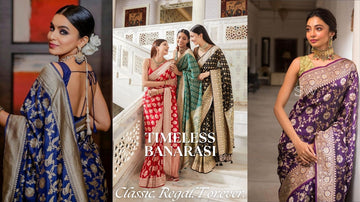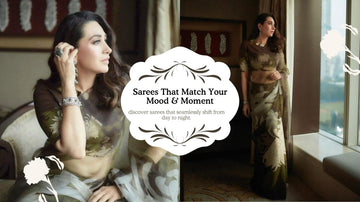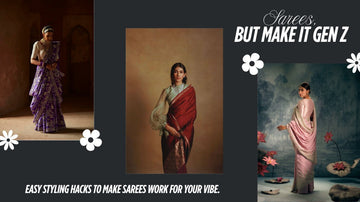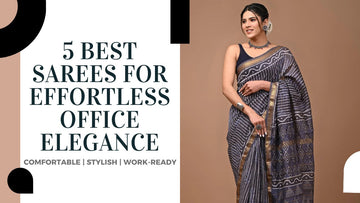Why Banarasi Sarees Are Perfect for Weddings and Festivals
Weddings and festivals in India are vibrant celebrations of colors, rituals, and traditions—and nothing captures that cultural richness quite like a Banarasi saree. With its royal roots and intricate craftsmanship, the Banarasi saree has become a timeless emblem of elegance, especially during life’s grandest occasions.
The Rich Heritage of Banarasi Sarees
Origin and Cultural Significance
Banarasi sarees, which originate from the ancient city of Varanasi, are deeply rooted in Indian tradition. Their origins trace back to the Mughal era when Persian-inspired motifs and weaving techniques met Indian textiles. Over centuries, these sarees became symbols of aristocracy and divine beauty.
Legacy of Weaving Techniques
Passed down through generations, the art of weaving Banarasi sarees is meticulous and time-consuming. Each drape is the culmination of weeks, and sometimes even months, of dedicated craftsmanship by skilled artisans.
What Makes Banarasi Sarees Unique?
Opulent Fabrics and Zari Work
Banarasi sarees are famous for their luxurious silk threads and stunning zari (gold or silver brocade) work. These metallic threads add unmatched richness and a regal glow that’s perfect for celebrations.
Timeless Designs and Patterns
Banarasi sarees are known for their elegant and classic designs that never go out of style. Inspired by Mughal art, nature, and traditional Indian motifs, these patterns add a royal touch to every saree. Banarasi sarees feature intricate floral motifs, delicate paisleys, and Mughal-inspired patterns, making them a visual treat. Each design tells a story of cultural richness.
Banarasi Sarees and Indian Weddings
Bridal Choice for Generations
The Banarasi saree has remained a go-to bridal wear for centuries. Its bold presence, intricate weave, and radiant fabric make it a favorite for brides seeking a traditional yet luxurious appeal.
Symbol of Luxury and Grace
Be it a wedding or an engagement ceremony, draping a Banarasi saree instantly elevates the aura of the wearer. It’s a garment that not only looks exquisite but also holds emotional and traditional value.
Festival Glamour with Banarasi Sarees
Ideal for Festive Celebrations
Festivals like Diwali, Durga Puja, and Raksha Bandhan are incomplete without traditional attire—and Banarasi sarees are the pinnacle of festive glam. The shimmer of zari complements the festive lights and the joy of the season.
Pairing with Traditional Jewelry
Styling a Banarasi saree with temple jewelry, jhumkas, or Kundan sets enhances its regal charm. Together, they create a look that feels timeless and celebratory.
Types of Banarasi Sarees
Katan
A pure silk variant, Katan Banarasi sarees are known for their durability and lustrous finish. They often feature elaborate motifs and are ideal for weddings.
Organza
These lightweight, sheer sarees have a distinct elegance, often adorned with zari and thread work, making them a modern favorite.
Georgette
A more flowy and subtle choice, georgette Banarasi sarees are perfect for pre-wedding functions and festivals where you want to look graceful yet feel light.
Shattir
This is the base fabric used to create contemporary Banarasi sarees, giving designers more freedom to experiment with styles.
Banarasi Sarees and Regional Influence
North India’s Bridal Staple
In North Indian cultures, particularly in UP and Bihar, Banarasi sarees are considered auspicious for bridal trousseaus. They’re often passed down as family heirlooms.
Widespread Popularity Across India
Beyond the north, the charm of Banarasi sarees has spread across states. From South Indian weddings to Bengali festivities, their universal appeal is undeniable. Whether it’s a bridal trousseau in Delhi, a festive outfit in Kolkata, or a traditional choice in Chennai, Banarasi sarees are embraced with love and pride. Their timeless beauty transcends regional styles, uniting diverse cultures under one elegant thread.
Modern Interpretations
Designer Collaborations
Many contemporary designers have infused Banarasi craftsmanship into lehengas, gowns, and fusion wear, making it popular among the younger generation.
Contemporary Styling Tips
Try draping it with a belt for a modern twist or pair it with a contrasting blouse for a chic fusion look. Banarasi sarees now cater to both traditional and modern fashion sensibilities.
Caring for Your Banarasi Saree
Storage Advice
Always store Banarasi sarees in a muslin cloth to keep them away from moisture. Refold them occasionally to avoid fabric creases or damage.
Cleaning and Maintenance
Avoid frequent washing. Instead, opt for dry cleaning, and never iron directly on the zari. Caring for your Banarasi saree is essential to keep it looking beautiful and timeless for years to come.
Banarasi sarees are not just clothing—they’re timeless treasures steeped in history, culture, and craftsmanship. Each Banarasi saree celebrates tradition and artistry through the shimmer of zari, intricate weaves, and the regal touch of silk. That’s exactly why they hold such a special place in Indian weddings and festivals. From being the bridal favorite to adding elegance during festive occasions, Banarasi sarees effortlessly combine beauty with cultural richness.
What makes them even more special is their versatility. Today’s Banarasi sarees can be styled in modern ways, worn by women of all ages, and passed down as heirlooms. So, whether you're a bride-to-be, attending a puja, or simply want to wear something classic and graceful, a Banarasi saree is always a great choice. It’s not just a fashion statement—it’s a legacy you wear. If you invest in one, you’ll always stay in style.









